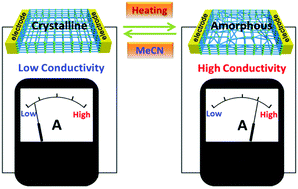Electrical bistability in a metal–organic framework modulated by reversible crystalline-to-amorphous transformations†
Abstract
Electrically bistable materials have important applications in memory, displays, switches, sensors, and quantum computation. This communication reports a metal–organic framework (MOF) material as a new type of electrically bistable material. Taking advantage of the flexible structure of MOF materials, the electrically bistable states of the MOF were reversibly modulated between its crystalline and amorphous phases. Interestingly, the material's amorphous phase exhibited anomalously higher conductivity than the crystalline phase. Our results illustrated a convenient method to develop electrically bistable materials from MOFs.



 Please wait while we load your content...
Please wait while we load your content...